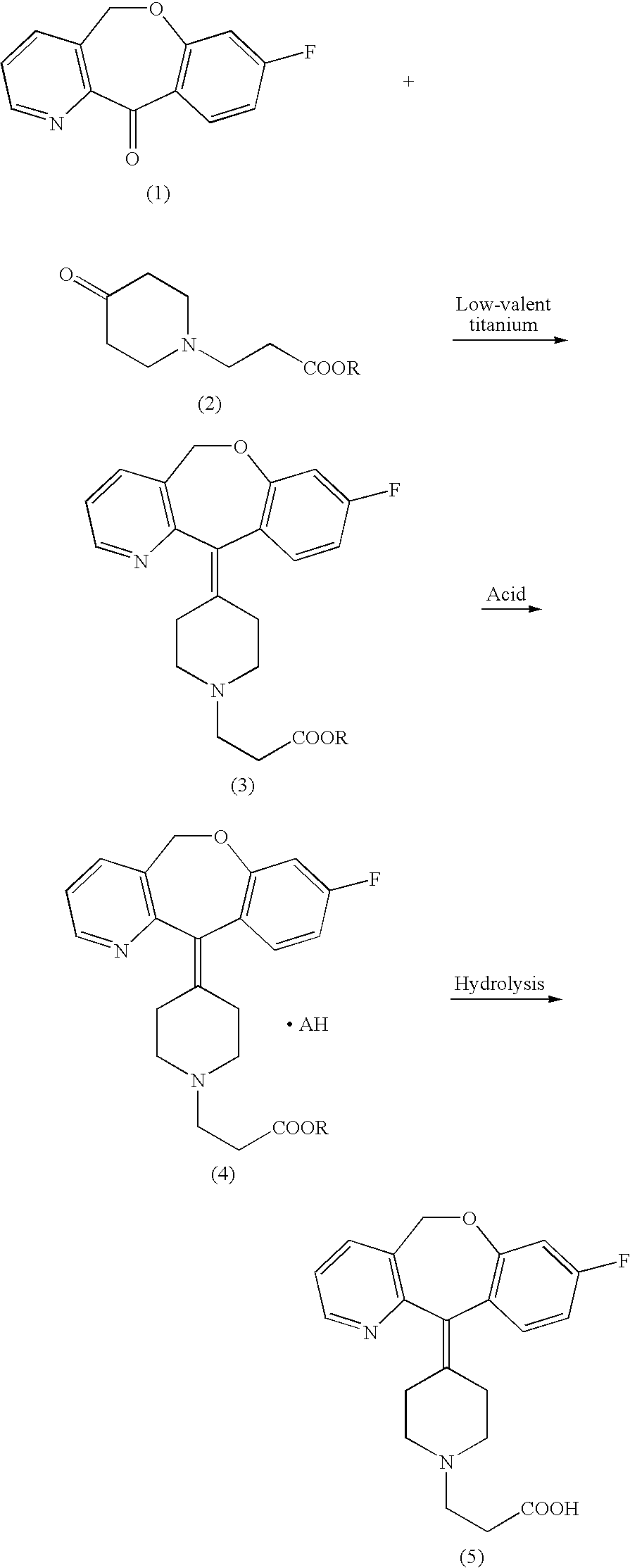Benzoxepino-11-piperidylidene compounds and process for production thereof
a technology of piperidylidene and benzoxepino, which is applied in the direction of biocide, drug composition, immunological disorders, etc., can solve the problems of difficult separation of insoluble matter by filtration, industrial disadvantage, and muddy insoluble matter formation during extraction, so as to achieve effective removal of impurities and high purity
- Summary
- Abstract
- Description
- Claims
- Application Information
AI Technical Summary
Benefits of technology
Problems solved by technology
Method used
Image
Examples
example 1
3-[4-(8-Fluoro-5,11-dihydrobenz[b]oxepino[4,3-b]pyridin-11-ylidene)piperidino]propionic acid ethyl ester
[0033] To a suspension of zinc (17.8 g) in anhydrous tetrahydrofuran (180 mL) was added dropwise titanium tetrachloride (9.65 mL) under ice-cooling in an argon atmosphere. After the reaction mixture was stirred under reflux for 2 hours, to the boiling mixture was promptly added a solution of 8-fluoro-11-oxo-5,11-dihydrobenz[b]oxepino[4,3-b]pyridin (10.0 g) and 3-(4-oxo-piperidin-1-yl)-propionic acid ethyl ester (8.7 g) in anhydrous tetrahydrofuran (135 mL) under reflux. After heating under reflux for 30 minutes, the reaction mixture was cooled to room temperature, incorporated with triethylamine (56.5 mL) and ethyl acetate (350 mL), and stirred with bubbles of air stream at 1 L / min under stirring at room temperature for 60 minutes. Precipitated insoluble matters were filtered through celite and washed twice with ethyl acetate (75 mL). The filtrate and the washing solution were co...
example 2
3-[4-(8-Fluoro-5,11-dihydrobenz[b]oxepino[4,3-b]pyridin-11-ylidene)piperidino]propionic acid ethyl ester hydrochloride
[0035] To a solution of the brown viscous oil (8.65 g) obtained in Example 1 in ethanol (69 mL) was added dropwise at room temperature a 4 mol / L hydrogen chloride-ethyl acetate solution (5.1 mL, 1 equivalent reduced to quantitative purity). After the solution was stirred for 15 minutes at room temperature, it was heated and stirred under reflux for 10 minutes. After termination of heating, the solution was allowed to gradually cool to room temperature, and then ice-cooled and stirred for 30 minutes. The resulting crystals were filtered off, washed with cold ethanol (9 mL) and then dried at 50° C. under reduced pressure to give 6.9 g of the aimed product (98.0%, HPLC) as pale yellow crystals.
[0036] m.p.: 199-200° C.
[0037] HPLC retention time: 5.9 minutes [column: Crestpack C18 T-5, 200 mm; solvent: acetonitrile-0.1% aqueous phosphoric acid solution (containing 5 mm...
example 3
3-[4-(8-Fluoro-5,11-dihydrobenz[b]oxepino[4,3-b]pyridin-11-ylidene)piperidino]propionic acid hydrochloride
[0038] To an aqueous solution (16.6 mL) of sodium hydroxide (2.5 mol / L) was added the pale yellow crystals (6.4 g: 98.0%, HPLC) obtained in Example 2, and the resulting mixture was stirred for 1 hour at an internal temperature of 60° C. The reaction mixture was acidified with 6 mol / L of hydrochloric acid to pH 5 under ice-cooling, added with 51 mL of ethyl acetate and again added dropwise with 6 mol / L of hydrochloric acid to adjust the pH to 3.8. After precipitation of crystals, the solution was adjusted to a pH in a range of from 3.3 to 3.5 and stirred for 30 minutes. The resulting crystals were filtered and washed with 10 mL of isopropanol. The crystals thus obtained were dried under reduced pressure to give 5.82 g of the aimed product (99.6%, HPLC) as colorless crystals.
[0039] m.p.: 182-184° C.
[0040] HPLC retention time: 6.1 minutes [column: Crestpack C18 T-5, 200 mm; solv...
PUM
 Login to View More
Login to View More Abstract
Description
Claims
Application Information
 Login to View More
Login to View More - R&D
- Intellectual Property
- Life Sciences
- Materials
- Tech Scout
- Unparalleled Data Quality
- Higher Quality Content
- 60% Fewer Hallucinations
Browse by: Latest US Patents, China's latest patents, Technical Efficacy Thesaurus, Application Domain, Technology Topic, Popular Technical Reports.
© 2025 PatSnap. All rights reserved.Legal|Privacy policy|Modern Slavery Act Transparency Statement|Sitemap|About US| Contact US: help@patsnap.com

